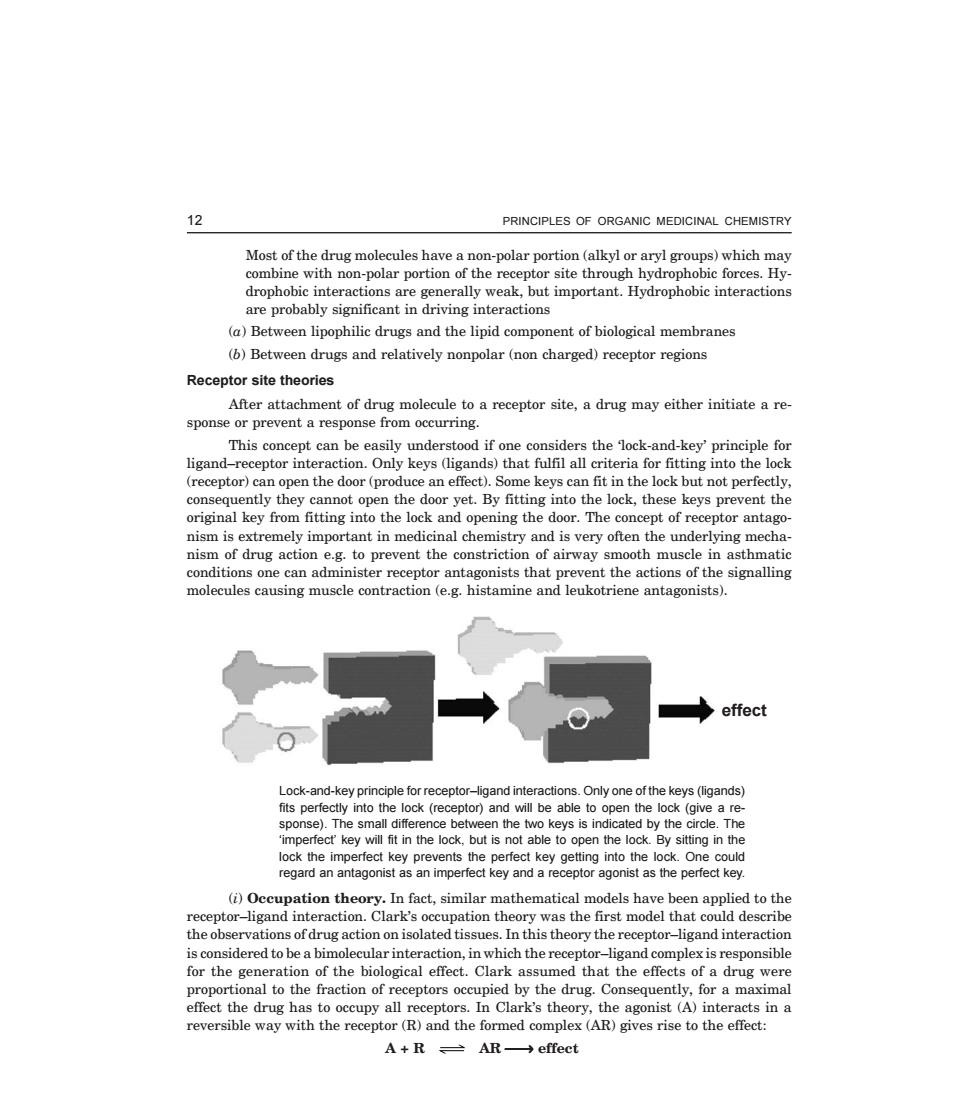正在加载图片...

12 PRINCIPLES OF ORGANIC MEDICINAL CHEMISTRY Most of the drug molecules have a non-polar portion(alkyl or aryl groups)which may combine with non-polar portion of the receptor site through hydrophobic forces.Hy- drophobic interactions are generally weak,but important.Hydrophobic interactions are probably significant in driving interactions (a)Between lipophilic drugs and the lipid component of biological membranes (b)Between drugs and relatively nonpolar(non charged)receptor regions Receptor site theories After attachment of drug molecule to a receptor site,a drug may either initiate a re- sponse or prevent a response from occurring. This concept can be easily understood if on ligand ds) t fulfil all pen the door(pr can fit in the lock but not pe uently they cannot open the door yet.By fitting into the lock,these keys pre vent the original key from fitting into the lock and opening the door.The concept of receptor antago- nism is extremely important in medicinal chemistry and is very often the underlying mecha- nism of drug action e.g.to prevent the constriction of airway smooth muscle in asthmatic conditions one can administer receptor antagonists that prevent the actions of the signalling molecules causing muscle contraction(e.g.histamine and leukotriene antagonists). effect s perfectly into the lock( tor)and will be able to。 o the a re onse).Th small difference between the two keys is indic by the circle.Th tin the ng in th rd an antagonist as an imperfect key and a receptor agonist as the perfect kev. (i)Occupation theory.In fact,similar mathematical models have been applied to the receptor-ligand interaction.Clark's occupation theory was the first model that could describe the observations of drug action on isolated tissues.In this theory the receptor-ligand interactio is considered tobe a bimolecular interaction,in which the receptor-ligand complex is responsible for the gene e bi ogical effect.Clar assum tha the ene f a drug wer I to the e fraction of eceptors occup rk th (A)in way with the occupy all agon eracts in a the comp AR gives ris to the A+RAR-effect 12 PRINCIPLES OF ORGANIC MEDICINAL CHEMISTRY C-8—N-CHEMI\CHE2-1.PM5 Most of the drug molecules have a non-polar portion (alkyl or aryl groups) which may combine with non-polar portion of the receptor site through hydrophobic forces. Hydrophobic interactions are generally weak, but important. Hydrophobic interactions are probably significant in driving interactions (a) Between lipophilic drugs and the lipid component of biological membranes (b) Between drugs and relatively nonpolar (non charged) receptor regions Receptor site theories After attachment of drug molecule to a receptor site, a drug may either initiate a response or prevent a response from occurring. This concept can be easily understood if one considers the ‘lock-and-key’ principle for ligand–receptor interaction. Only keys (ligands) that fulfil all criteria for fitting into the lock (receptor) can open the door (produce an effect). Some keys can fit in the lock but not perfectly, consequently they cannot open the door yet. By fitting into the lock, these keys prevent the original key from fitting into the lock and opening the door. The concept of receptor antagonism is extremely important in medicinal chemistry and is very often the underlying mechanism of drug action e.g. to prevent the constriction of airway smooth muscle in asthmatic conditions one can administer receptor antagonists that prevent the actions of the signalling molecules causing muscle contraction (e.g. histamine and leukotriene antagonists). effect Lock-and-key principle for receptor–ligand interactions. Only one of the keys (ligands) fits perfectly into the lock (receptor) and will be able to open the lock (give a response). The small difference between the two keys is indicated by the circle. The ‘imperfect’ key will fit in the lock, but is not able to open the lock. By sitting in the lock the imperfect key prevents the perfect key getting into the lock. One could regard an antagonist as an imperfect key and a receptor agonist as the perfect key. (i) Occupation theory. In fact, similar mathematical models have been applied to the receptor–ligand interaction. Clark’s occupation theory was the first model that could describe the observations of drug action on isolated tissues. In this theory the receptor–ligand interaction is considered to be a bimolecular interaction, in which the receptor–ligand complex is responsible for the generation of the biological effect. Clark assumed that the effects of a drug were proportional to the fraction of receptors occupied by the drug. Consequently, for a maximal effect the drug has to occupy all receptors. In Clark’s theory, the agonist (A) interacts in a reversible way with the receptor (R) and the formed complex (AR) gives rise to the effect: A + R AR → effect